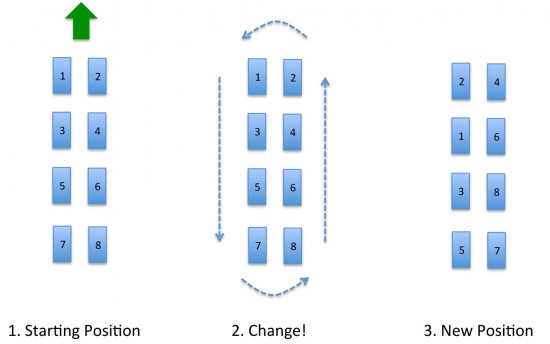It’s great to see so many new and enthusiastic riders out on the club runs.
We’ve had some questions recently about the technique and etiquette of riding in a group. Here are a few tips.
It is much easier to ride in a group than by yourself. This is because riding behind another rider is about 30% easier than riding at the front. That might not sound huge, but human physiology is a strange thing! I can ride for about 5 minutes at 80% of my maximum power, but for several hours at 60%, so riding effectively in a group makes a big difference.
Riders in a group need an efficient way to share the hard work at the front of the group. Here we look at the basics of doing that.
Let’s consider a group of 8 riders (numbered 1-8 in the left picture below). Riders 1 and 2 are at the front. The other riders are in pairs behind. There should be 2-3 feet between the pairs of riders, and the group should look neat (like the picture)!
When the club captain shouts, “Change!”, the group should rotate as shown in the second picture, with the riders ending up in the position shown in the third picture.

Here are some other points to note –
- Normally, in a club run, there will be 2-5 minutes between changes. Shorter changes are usually associated with faster speeds.
- When at the front, you shouldn’t “half wheel” your partner. The two bicycles should be level (as shown). Neither rider should try to “force” the pace. There will be plenty of opportunities to do that in races – for now, learn the techniques of riding in a group and enjoy the ride.
- The riders behind should also try to ride level in their pairs, otherwise the group will look messy and ragged. And you’ll have no-one to talk to!
- During the change, riders in the left hand column should ease slightly, and riders in the right hand column should move up smoothly. Try to avoid jerky behaviour, or sudden accelerations, which can disrupt the smooth working of the group.
- If you’re too tired to share the work, you should sit at the back (position 7 or 8). When there is a change, let the other riders change in front of you. Do not get sucked into the right hand column, as you’ll disrupt the group.
- If you think the group is going too hard, or you see someone getting dropped, don’t be afraid to shout, “Easy!” to let the leading pair know to ease their pace. A club run is supposed to be a social event – not a race!
- In wet weather, it is good form to use mudguards. This protects you from spray, and also the riders behind you. Clip on mudguards are relatively cheap and easy to fit, so there is no excuse.
- If you see a hazard, like a pot hole or broken glass, shout a warning to let your companions know about it, and point if safe to do so. The League of American Wheelmen used to advise shouting “Rocks!” for all hazards, which is good fun, but we generally shout something more specific.
So – that’s the basics. At first it will feel strange riding in a group, but most riders soon get the hang of it. As confidence builds, the riders will be able to ride closer together, and the group will become neater and more efficient.
There are lots of more advance techniques used in racing, to cope with side winds, etc., but you don’t need to worry about those on the open road in a club run situation. We’ll cover more about these in a future article.
Hopefully we’ll get a chance to practice some of this in a more controlled setting on the club run on Tuesday 19th May.
Finally, here’s a link to an article on stickybottle.com about group riding. It’s mainly a safety video about riding two abreast, but it shows how neat and well presented a group of club cyclists can look.
